

E-Learning at SOAS. How to Use Social Media as a Learning Tool. Social media is an ingrained part of today’s society.
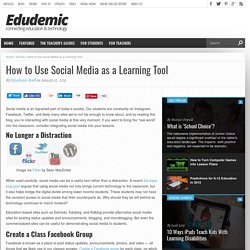
Our students are constantly on Instagram, Facebook, Twitter, and likely many sites we’re not hip enough to know about, and by reading this blog, you’re interacting with social media at this very moment. If you want to bring the “real world” into the classroom, consider integrating social media into your lessons. No Longer a Distraction Image via Flickr by Sean MacEntee When used carefully, social media can be a useful tool rather than a distraction. Education-based sites such as Edmodo, Edublog, and Kidblog provide alternative social media sites for posting status updates and announcements, blogging, and microblogging. Create a Class Facebook Group Facebook is known as a place to post status updates, announcements, photos, and video — all things that we likely use in our classes anyway. A Facebook group also creates a space for students to ask and answer questions. Start a Topical Twitter Feed. Change the privacy settings for your video - YouTube Help. A private video can only be seen by you and the users you select.
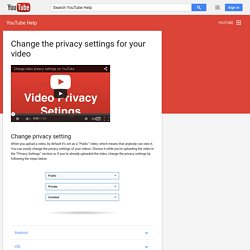
The video won’t appear on your channel or search results and will be invisible to other users. 9780262515016_Open_Access_Edition.pdf. Guidelines for media management in higher education. A media management strategy and its attendant platforms need to support a policy framework that addresses institutional responsibilities towards student learning, student well-being and personal development, including over-arching accessibility policy objectives.
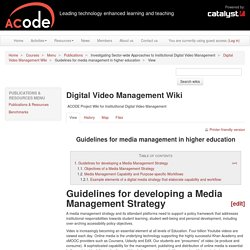
Video is increasingly becoming an essential element at all levels of Education. Four billion Youtube videos are viewed each day. Online media is the underlying technology supporting the highly successful Khan Academy and xMOOC providers such as Coursera, Udacity and EdX. What is Web 2.0.pdf. COFA Online Gateway. How to Be More Open to Learning New Technology: 8 Steps. Edit Article Sometimes it can be hard to accept that you're behind the times.
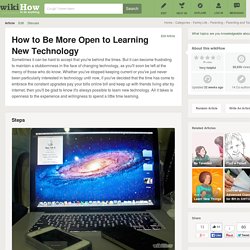
But it can become frustrating to maintain a stubbornness in the face of changing technology, as you'll soon be left at the mercy of those who do know. Whether you've stopped keeping current or you've just never been particularly interested in technology until now, if you've decided that the time has come to embrace the constant upgrades pay your bills online bill and keep up with friends living afar by internet, then you'll be glad to know it's always possible to learn new technology. All it takes is openness to the experience and willingness to spend a little time learning. Ad Steps <img alt="Be More Open to Learning New Technology Step 1.jpg" src=" width="670" height="503">1Think about the perks of learning more about new technology. COFA Online Gateway. Game ChangersEducInfoTechnologies. Death to the Digital Dropbox: Rethinking Student Privacy and Public Performance. Key Takeaways Requiring students to submit work privately using a digital dropbox (or even worse, e-mail) can be a destructive pedagogical practice.
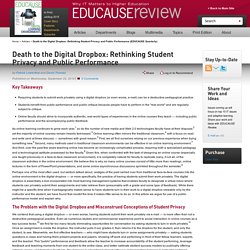
Students benefit from public performance and public critique because people have to perform in the "real world" and are regularly subject to critique. Online faculty should strive to incorporate authentic, real-world types of experiences in the online courses they teach — including public performance and the accompanying public feedback. Perhaps one of the most often used, but seldom talked about, vestiges of the past carried over from traditional face-to-face courses into the online environment is the digital dropbox — or more specifically, the practice of having students submit their work privately. The Problem with the Digital Dropbox and Misconstrued Conceptions of Student Privacy Private feedback has its place in education.12 We contend, however, that the vast majority of feedback can and should be public.
Privacy Figure 1. Figure 2. Hope.pdf. LAMS Foundation. Respondus. Features. Higher Education’s First Active Learning Platform. Watch the Online Video Course Up and Running with Desire2Learn. Moodle - Open-source learning platform. Redirecting. 21stcenturywalton.pbworks.com/f/What is Web 2.0.pdf. The Barriers To Using Social Media In Education (Part 1 of 2)
“When you step away from the prepackaged structure of traditional education, you’ll discover that there are many more ways to learn outside school than within.” - Kio Start In this article, we have analysed the impact of social media on the education sector while also empathizing with educators on their resistance to the use of it in the classroom.
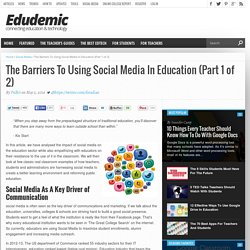
We will then look at few classic real classroom examples of how teachers, students and administrators are harnessing social media to create a better learning environment and reforming public education. Social Media As A Key Driver of Communication social media is often seen as the key driver of communications and marketing. In 2012-13, The US department of Commerce ranked 55 industry sectors for their IT intensiveness, education ranked lowest (below coal mining). We’re not talking about the number of machines lying in your computer lab or iPads in the classroom.
We humans have a whole history of being resistant to change. Why Resistance? How are students really using mobile technologies for learning? (full version) Death to the Digital Dropbox: Rethinking Student Privacy and Public Performance. Directory of Learning & Performance Tools. National VET E-learning Strategy. Using external services and tools to support learning and teaching.